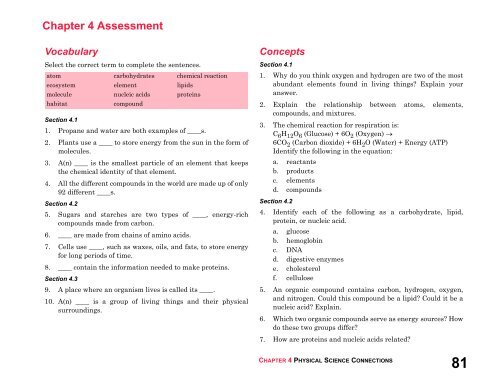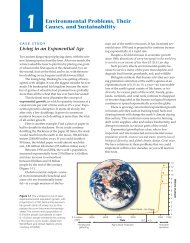Chapters 4 - Spokane Public Schools
Chapters 4 - Spokane Public Schools
Chapters 4 - Spokane Public Schools
Create successful ePaper yourself
Turn your PDF publications into a flip-book with our unique Google optimized e-Paper software.
Chapter 4 Assessment<br />
Vocabulary<br />
Select the correct term to complete the sentences.<br />
atom<br />
ecosystem<br />
molecule<br />
habitat<br />
Section 4.1<br />
1. Propane and water are both examples of ____s.<br />
2. Plants use a ____ to store energy from the sun in the form of<br />
molecules.<br />
3. A(n) ____ is the smallest particle of an element that keeps<br />
the chemical identity of that element.<br />
4. All the different compounds in the world are made up of only<br />
92 different ____s.<br />
Section 4.2<br />
5. Sugars and starches are two types of ____, energy-rich<br />
compounds made from carbon.<br />
6. ____ are made from chains of amino acids.<br />
7. Cells use ____, such as waxes, oils, and fats, to store energy<br />
for long periods of time.<br />
8. ____ contain the information needed to make proteins.<br />
Section 4.3<br />
carbohydrates<br />
element<br />
nucleic acids<br />
compound<br />
chemical reaction<br />
lipids<br />
proteins<br />
9. A place where an organism lives is called its ____.<br />
10. A(n) ____ is a group of living things and their physical<br />
surroundings.<br />
Concepts<br />
Section 4.1<br />
1. Why do you think oxygen and hydrogen are two of the most<br />
abundant elements found in living things Explain your<br />
answer.<br />
2. Explain the relationship between atoms, elements,<br />
compounds, and mixtures.<br />
3. The chemical reaction for respiration is:<br />
C 6 H 12 O 6 (Glucose) + 6O 2 (Oxygen) <br />
6CO 2 (Carbon dioxide) + 6H 2 O (Water) + Energy (ATP)<br />
Identify the following in the equation:<br />
a. reactants<br />
b. products<br />
c. elements<br />
d. compounds<br />
Section 4.2<br />
4. Identify each of the following as a carbohydrate, lipid,<br />
protein, or nucleic acid.<br />
a. glucose<br />
b. hemoglobin<br />
c. DNA<br />
d. digestive enzymes<br />
e. cholesterol<br />
f. cellulose<br />
5. An organic compound contains carbon, hydrogen, oxygen,<br />
and nitrogen. Could this compound be a lipid Could it be a<br />
nucleic acid Explain.<br />
6. Which two organic compounds serve as energy sources How<br />
do these two groups differ<br />
7. How are proteins and nucleic acids related<br />
CHAPTER 4 PHYSICAL SCIENCE CONNECTIONS<br />
81

















